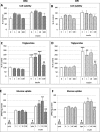Opuntia cladode powders inhibit adipogenesis in 3 T3-F442A adipocytes and a high-fat-diet rat model by modifying metabolic parameters and favouring faecal fat excretion
- PMID: 32024512
- PMCID: PMC7076822
- DOI: 10.1186/s12906-020-2824-x
Opuntia cladode powders inhibit adipogenesis in 3 T3-F442A adipocytes and a high-fat-diet rat model by modifying metabolic parameters and favouring faecal fat excretion
Abstract
Background: Obesity is a major public health concern worldwide. A sedentary life and a nutritional transition to processed foods and high-calorie diets are contributing factors to obesity. The demand for nutraceutical foods, such as herbal weight-loss products, which offer the potential to counteract obesity, has consequently increased. We hypothesised that Opuntia cladodes consumption could assist weight management in an obesity prevention context.
Methods: This study was designed to explore the anti-adipogenic effects of lyophilised Opuntia cladode powders (OCP) in an in vitro cellular model for adipocyte differentiation and an in vivo high-fat-diet (HFD)-induced obesity rat model. Two OCP were tested, one from wild species O. streptacantha and the second from the most known species O. ficus-indica.
Results: Pre-adipocytes 3 T3-F442A were treated by OCP during the differentiation process by insulin. OCP treatment impaired the differentiation in adipocytes, as supported by the decreased triglyceride content and a low glucose uptake, which remained comparable to that observed in undifferentiated controls, suggesting that an anti-adipogenic effect was exerted by OCP. Sprague-Dawley rats were fed with a normal or HFD, supplemented or not with OCP for 8 weeks. OCP treatment slightly reduced body weight gain, liver and abdominal fat weights, improved some obesity-related metabolic parameters and increased triglyceride excretion in the faeces. Taken together, these results showed that OCP might contribute to reduce adipogenesis and fat storage in a HFD context, notably by promoting the faecal excretion of fats.
Conclusions: Opuntia cladodes may be used as a dietary supplement or potential therapeutic agent in diet-based therapies for weight management to prevent obesity.
Keywords: 3T3-F442A adipocytes; Anti-obesity; Faecal fat excretion; Opuntia; Rat high-fat diet.
Conflict of interest statement
The authors declare that they have no competing interests.
Figures





Similar articles
-
Usefulness of Opuntia spp. on the Management of Obesity and Its Metabolic Co-Morbidities.Nutrients. 2024 Apr 25;16(9):1282. doi: 10.3390/nu16091282. Nutrients. 2024. PMID: 38732528 Free PMC article. Review.
-
Caulerpa okamurae extract inhibits adipogenesis in 3T3-L1 adipocytes and prevents high-fat diet-induced obesity in C57BL/6 mice.Nutr Res. 2017 Nov;47:44-52. doi: 10.1016/j.nutres.2017.09.002. Epub 2017 Sep 14. Nutr Res. 2017. PMID: 29241577
-
Annual Wormwood Leaf Inhibits the Adipogenesis of 3T3-L1 and Obesity in High-Fat Diet-Induced Obese Rats.Nutrients. 2017 May 28;9(6):554. doi: 10.3390/nu9060554. Nutrients. 2017. PMID: 28555033 Free PMC article.
-
5,7-Dimethoxyflavone Attenuates Obesity by Inhibiting Adipogenesis in 3T3-L1 Adipocytes and High-Fat Diet-Induced Obese C57BL/6J Mice.J Med Food. 2016 Dec;19(12):1111-1119. doi: 10.1089/jmf.2016.3800. Epub 2016 Nov 9. J Med Food. 2016. PMID: 27828718
-
Prickly Pear Cacti (Opuntia spp.) Cladodes as a Functional Ingredient for Hyperglycemia Management: A Brief Narrative Review.Medicina (Kaunas). 2022 Feb 16;58(2):300. doi: 10.3390/medicina58020300. Medicina (Kaunas). 2022. PMID: 35208623 Free PMC article. Review.
Cited by
-
Usefulness of Opuntia spp. on the Management of Obesity and Its Metabolic Co-Morbidities.Nutrients. 2024 Apr 25;16(9):1282. doi: 10.3390/nu16091282. Nutrients. 2024. PMID: 38732528 Free PMC article. Review.
-
Medicinal Plant Extracts against Cardiometabolic Risk Factors Associated with Obesity: Molecular Mechanisms and Therapeutic Targets.Pharmaceuticals (Basel). 2024 Jul 21;17(7):967. doi: 10.3390/ph17070967. Pharmaceuticals (Basel). 2024. PMID: 39065815 Free PMC article. Review.
-
Effects of Opuntia stricta var. dillenii Extracts Obtained from Prickly Pear and an Industrial By-Product on Maturing Pre-Adipocytes.Plants (Basel). 2024 Oct 24;13(21):2967. doi: 10.3390/plants13212967. Plants (Basel). 2024. PMID: 39519886 Free PMC article.
-
Selected Mesoamerican Crops - Anti-Obesity Potential and Health Promotion. A Review.Plant Foods Hum Nutr. 2024 Sep;79(3):563-570. doi: 10.1007/s11130-024-01211-9. Epub 2024 Aug 6. Plant Foods Hum Nutr. 2024. PMID: 39105985 Free PMC article. Review.
-
Structure-Function Relationships and Health-Promoting Properties of the Main Nutraceuticals of the Cactus Pear (Opuntia spp.) Cladodes: A Review.Molecules. 2024 Oct 7;29(19):4732. doi: 10.3390/molecules29194732. Molecules. 2024. PMID: 39407660 Free PMC article. Review.
References
-
- WHO | Obesity and overweight. WHO n.d. https://www.who.int/news-room/fact-sheets/detail/obesity-and-overweight. Accessed 26 Oct 2017.
-
- World Cancer Research Fund/American Institute for Cancer Research. Continuous Update Project Expert Report 2018. Diet, nutrition and physical activity: Energy balance and body fatness. 2018. Available at https://www.wcrf.org/dietandcancer/energy-balance-body-fatness.
-
- Avila-Nava Azalia, Noriega Lilia G., Tovar Armando R., Granados Omar, Perez-Cruz Claudia, Pedraza-Chaverri José, Torres Nimbe. Food combination based on a pre-hispanic Mexican diet decreases metabolic and cognitive abnormalities and gut microbiota dysbiosis caused by a sucrose-enriched high-fat diet in rats. Molecular Nutrition & Food Research. 2016;61(1):1501023. doi: 10.1002/mnfr.201501023. - DOI - PubMed
MeSH terms
Substances
Grants and funding
LinkOut - more resources
Full Text Sources
Medical

